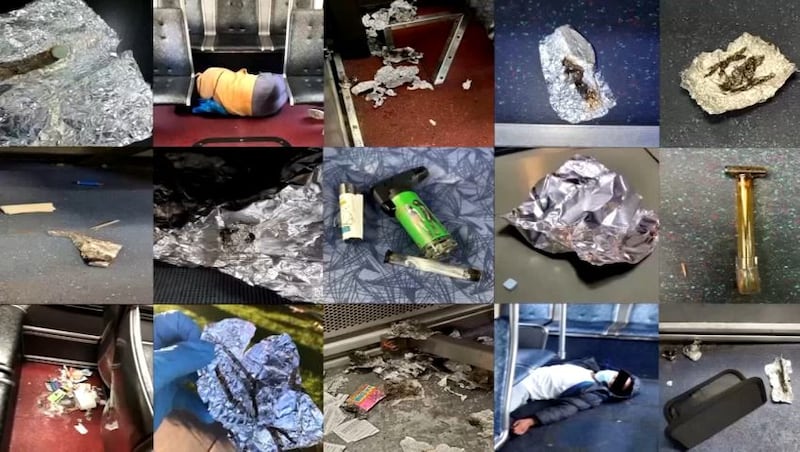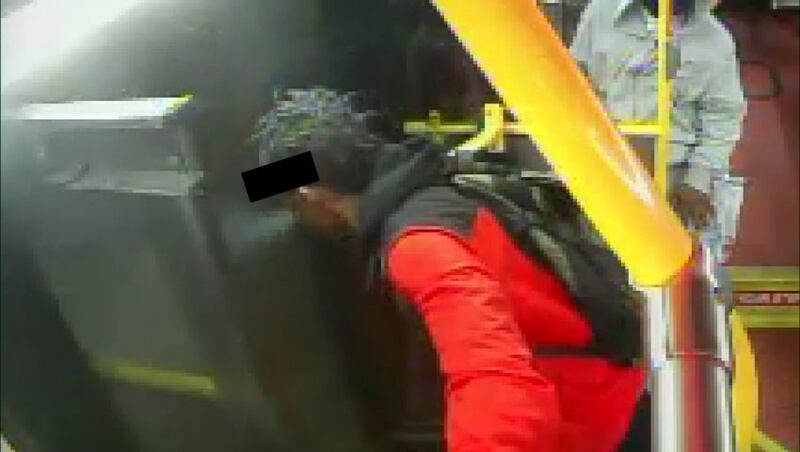KING COUNTY, Wash. — Lurking inside countless King County Metro Transit buses and trains is growing frustration over dangerous fumes from America’s deadliest drug.
According to several Metro Transit drivers and the union representing thousands more, blue counterfeit M-30 oxycodone pills — commonly laced with fentanyl — are openly smoked or “freebased” by riders aboard buses and trains, exposing riders and operators to fumes often described as “sickening.”
“Every morning it’s the same thing,” said Feanette Black Bear, who said she has relied on Metro Transit for her daily commute to work at 4:30 a.m. Black Bear said on almost every trip, she winces at the sharp odor of fentanyl smoke, which she said makes her sick. “You can see them doing it, then you smell it.” She said she wears two masks, hoping to protect herself from the fumes.
The fentanyl pills, commonly known as “blues” or “30s” on the street, are now so plentiful and cheap, police say they’ve commonly replaced the street markets of even heroin and methamphetamine. Users typically roast the blue pills into smoke and vapor on tin foil with a torch, and inhale it with a straw. KIRO-7 crews saw users often quickly slumping into a zombielike state of short-term unconsciousness after inhaling the fentanyl vapors.
“It’s all day, every day,” said daily Metro Transit commuter Tyrone Thomas.
Frequent rider Tyler Miller agreed. “It’s (happening) on every other bus I’d say, to be honest with you.”
KIRO-7 News crews boarded Metro buses and often found the effects of fentanyl use hard to miss, with some users seen unconscious. From bus stops, users could be seen smoking the pills with passengers sitting and standing nearby.
“It’s getting to where I’m afraid to go to work anymore,” said a veteran Metro Transit bus driver, who asked KIRO-7 not to identify him because he said drivers could be reprimanded or fired for speaking to media. The driver said he has been taken out of service in the middle of a route by a supervisor after feeling impaired by fentanyl fumes.
“They (fentanyl users) do this without any regard to who else is on the bus,” he said. “The most disturbing cases I’ve seen are people doing it right behind unsuspecting families with children,” adding that many passengers can’t identify what the smell is — described as burning peanut butter mixed with drain cleaner — or what it may be doing to them.
“Operators ... say, ‘I’m getting sick,’” said Cory Rigtrup, Vice President of Amalgamated Transit Union Local 587, which represents King County Metro Transit drivers. “They say, ‘I’m getting headaches, I’m getting dizzy.’ I stop the bus, I pull over and let people off because they’re experiencing the same thing. They want off the bus.”
The pills are smoked in the open on the streets of Seattle, even while police are nearby. After the 2021 State V. Blake decision by the Washington State Supreme Court, simple possession of drugs, including fentanyl, has been decriminalized; but fentanyl overdoses have become the leading cause of death for American adults ages 18 to 45. King County has seen an increase of 650% in fentanyl overdose deaths over the past five years.
Metro drivers posted video on social media platforms showing them trying to get smokers’ attention or to stop, but drivers tell KIRO-7 fentanyl smokers are very rarely deterred, even when they know they’re being recorded.
“It’s insane. It’s out of control,” said Rigtrup, who noted that the issue of fentanyl fumes didn’t seem to be an issue eight months ago. He said hundreds of buses and light rail trains became littered with scorched foil, darkened with fentanyl residue.
“Somewhere along the way, someone said it’s cool to smoke drugs on the bus,” Rigtrup said. “No one’s going to stop you, and that’s where we are today.”
Drivers say users have told them smoking fentanyl outside in moving air scatters the fragile fumes. “What’s been explained to me is that it’s desirable to smoke the drugs on the bus,” Rigtrup said. That’s the ideal place.”
“This is a passionate topic for me. I want my riders back, folks,” said Erik Christensen, a Metro driver for 22 years who recently begged members of the King County Council to understand the urgency.
“You see the picture in my background,” asked Christensen, while testifying in a public forum via Zoom. “That’s not a random picture. That’s from one trip on the train,” he said. They sat back there, and each one of those pieces of foil represents somebody using fentanyl on one trip. This happens daily on our buses — daily.”
“We could have a driver collapse,” said the unidentified driver. “There’s all sorts of scenarios that I worry about, with a driver who may be high on fentanyl.”
Metro Transit drivers have told KIRO-7 and the ATU that police will not typically intervene or remove someone smoking fentanyl on public transit. “I’ve had King County Sheriff Deputies within feet of the individual smoking, and said they couldn’t do anything,” said the driver.
A new pilot program just introduced by Metro bolsters the number of unarmed transit security guards. The Safety, Security, and Fare Enforcement (SaFE) Reform Initiative includes a plan to hire dozens of guards.
In a written statement to KIRO-7, King County Metro Transit noted there is supposed to be enforcement of laws regarding smoking and drug use. “We work on keeping our passengers and operators safe and Metro has existing policies in place: smoking and drug use continue to be a violation of Metro’s Code of Conduct,” read a statement from King County Metro spokesman Jeff Switzer. “Our policies also say that passengers could be requested to disembark from the coach or transit facility (shelters, transit centers, and Park and Rides) and subject to a criminal citation.”
Switzer said the “standard procedure” for unarmed transit safety officers is to make verbal contact, and try to gain compliance peacefully and respectfully from the a rider who is violating the Code of Conduct, “in an effort to keep the coach moving and to get other riders to their destination without delays.
“If the person does not comply, the Transit Security Officers (TSOs) will request the rider to deboard the coach at the next stop. Switzer said if a rider refuses to leave, additional steps can be taken, but “Transit Security Officers have not been authorized to physically remove anyone from the coach unless the person poses an imminent safety risk to other riders or the officers.” Switzer added, “New Transit Security Officers receive standard training which includes guidance for interaction with people who are engaged in illegal activity, including smoking drugs on buses and at transit locations.”
“You could put 200 security guards out there, it would not help the problem of smoking fentanyl on the buses because it’s too widespread,” said the unidentified driver, who added that his fellow drivers are often advised to take their bus out of service if a drug using rider is unconscious, or refuses to leave. “They would leave the person on until they decided they were ready to leave,” he said.
“The only option (supervisors) have given me was to go ‘sick on the road,’ to shut the bus down, tell everybody to get off and end service for that route.
The driver said he tried writing letters to several state lawmakers, detailing problems and the lack of authority to stop it, and asking legislators for a specific law to ban smoking opioids on public transit.
“I think it needs to be a serious crime to smoke these drugs on public transportation,” he said.
Drivers say without security help, they are their own last line of defense.
“My only option is to stop the bus and ask somebody in the throes of drug addiction, ‘Please stop doing that?’ It doesn’t work. We need a show of force on these buses,” said Christensen.
“There needs to be some enforcement of the rules,” said Rigtrup. “Metro has a policy saying I can’t eat potato chips on the bus; but smoking fentanyl is OK? Someone needs to enforce the rules of conduct.”
Feanette Black Bear told KIRO-7 she extends an open invitation to anyone in charge, “from Seattle’s mayor, to the county executive, to the governor” to join her on board the bus she takes to work.
“Ride the bus and see for himself what’s going on,” she said.
Follow-up investigation:
Metro bus driver and local mayor describe increasing concern for riders from fentanyl fumes
©2022 Cox Media Group








